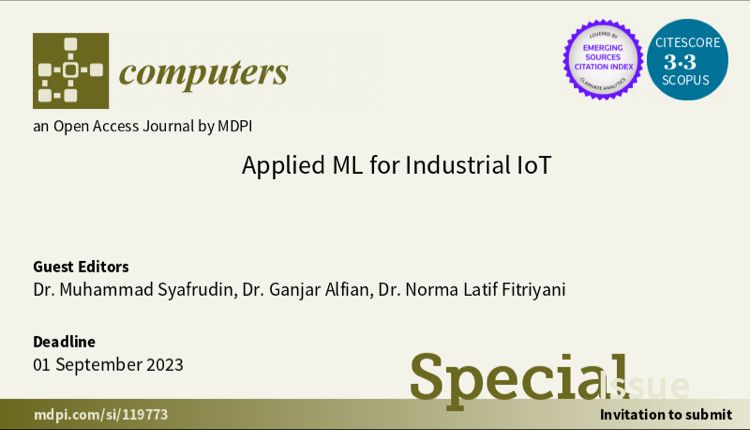
My colleagues and I are guest editing a special issue related to the application of #machinelearning and #IoT in industry, which will be published continuously by Computers (Scopus SJR Q2).

My colleagues and I are guest editing a special issue related to the application of #machinelearning and #IoT in industry, which will be published continuously by Computers (Scopus SJR Q2).
Abstract
Maintaining product quality is essential for smart factories, hence detecting abnormal events in assembly line is important for timely decision-making. This study proposes an affordable fast early warning system based on edge computing to detect abnormal events during assembly line. The proposed model obtains environmental data from various sensors including gyroscopes, accelerometers, temperature, humidity, ambient light, and air quality. The fault model is installed close to the facilities, so abnormal events can be timely detected. Several performance evaluations are conducted to obtain the optimal scenario for utilizing edge devices to improve data processing and analysis speed, and the final proposed model provides the highest accuracy in terms of detecting abnormal events compared to other classification models. The proposed model was tested over four months of operation in a Korean automobile parts factory, and provided significant benefits from monitoring assembly line, as well as classifying abnormal events. The model helped improve decision-making by reducing or preventing unexpected losses due to abnormal events.
Published in: Applied Sciences
DOI: 10.3390/app9010084
Abstract
Current technology such as Bluetooth Low Energy (BLE) provides an efficient way for Real-Time Location System (RTLS). This study proposes a BLE-based Real-Time Location System that utilizes Smartphone and NoSQL database as gateway and data storage respectively. Firstly, we develop a smartphone-based tracking app to gather the location of employees. Secondly, the generated sensor data from gateway is then stored into NoSQL MongoDB. The proposed system was tested for monitoring the movement of employees in the workplace. The results showed that commercial versions of the BLE-based device and the proposed system are sufficiently efficient for RTLS. Furthermore, proposed system is capable of processing a massive input/output of sensor data efficiently when the number of BLE-based devices and users increases.
Published in: BDIOT 2018 Proceedings of the 2018 2nd International Conference on Big Data and Internet of Things, ACM New York, NY, USA ©2018
DOI: 10.1145/3289430.3289470
Abstract
With the increase in the amount of data captured during the manufacturing process, monitoring systems are becoming important factors in decision making for management. Current technologies such as Internet of Things (IoT)-based sensors can be considered a solution to provide efficient monitoring of the manufacturing process. In this study, a real-time monitoring system that utilizes IoT-based sensors, big data processing, and a hybrid prediction model is proposed. Firstly, an IoT-based sensor that collects temperature, humidity, accelerometer, and gyroscope data was developed. The characteristics of IoT-generated sensor data from the manufacturing process are: real-time, large amounts, and unstructured type. The proposed big data processing platform utilizes Apache Kafka as a message queue, Apache Storm as a real-time processing engine and MongoDB to store the sensor data from the manufacturing process. Secondly, for the proposed hybrid prediction model, Density-Based Spatial Clustering of Applications with Noise (DBSCAN)-based outlier detection and Random Forest classification were used to remove outlier sensor data and provide fault detection during the manufacturing process, respectively. The proposed model was evaluated and tested at an automotive manufacturing assembly line in Korea. The results showed that IoT-based sensors and the proposed big data processing system are sufficiently efficient to monitor the manufacturing process. Furthermore, the proposed hybrid prediction model has better fault prediction accuracy than other models given the sensor data as input. The proposed system is expected to support management by improving decision-making and will help prevent unexpected losses caused by faults during the manufacturing process.
Published in: Sensors
DOI: 10.3390/s18092946
Abstract
Current technology provides an efficient way of monitoring the personal health of individuals. Bluetooth Low Energy (BLE)-based sensors can be considered as a solution for monitoring personal vital signs data. In this study, we propose a personalized healthcare monitoring system by utilizing a BLE-based sensor device, real-time data processing, and machine learning-based algorithms to help diabetic patients to better self-manage their chronic condition. BLEs were used to gather users’ vital signs data such as blood pressure, heart rate, weight, and blood glucose (BG) from sensor nodes to smartphones, while real-time data processing was utilized to manage the large amount of continuously generated sensor data. The proposed real-time data processing utilized Apache Kafka as a streaming platform and MongoDB to store the sensor data from the patient. The results show that commercial versions of the BLE-based sensors and the proposed real-time data processing are sufficiently efficient to monitor the vital signs data of diabetic patients. Furthermore, machine learning–based classification methods were tested on a diabetes dataset and showed that a Multilayer Perceptron can provide early prediction of diabetes given the user’s sensor data as input. The results also reveal that Long Short-Term Memory can accurately predict the future BG level based on the current sensor data. In addition, the proposed diabetes classification and BG prediction could be combined with personalized diet and physical activity suggestions in order to improve the health quality of patients and to avoid critical conditions in the future.
Published in: Sensors
DOI: 10.3390/s18072183
Abstract
Smart factory is quickly becoming the new reality in the market, and every innovative manufacturer must embrace it to stay competitive.
Abstract
Currently, the manufacturing industry is experiencing a data-driven revolution. There are multiple processes in the manufacturing industry and will eventually generate a large amount of data. Collecting, analyzing and storing a large amount of data are one of key elements of the smart manufacturing industry.